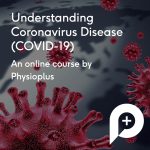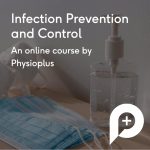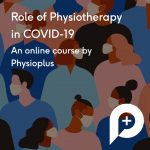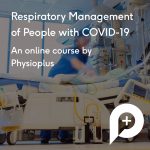These courses will be available for free to trial and full Physioplus account holders until the end of April 2020 (this deadline could be revised at a later date).
In January 2020 a new coronavirus was identified from a cluster of cases in the city of Wuhan, China. By mid March this virus outbreak was declared a pandemic by the WHO having infected over 150,000 individuals and caused over 5000 fatalities in 123 countries around the world.
All healthcare workers including physiotherapists / physical therapists have a vital role to play in the global efforts to manage the impact of this disease. This series of courses pulls together information relevant to all rehabilitation professionals to assist them to develop an understanding of the virus and the related disease, and to explore their role in working to treat related patients and also to contain and mitigate the disease.
Courses Within The Programme
Understanding COVID-19

Coronaviruses are a family of viruses that cause illnesses such as respiratory or gastrointestinal diseases. In January 2020 a previously unknown coronavirus was identified in Wuhan China. The group of conditions related with infection by this new virus was named Coronavirus Disease 2019 (COVID-19) by the World Health Organisation (WHO). Following its rapid spread around the globe, the WHO has declared the COVID-19 a pandemic. It mainly presents with respiratory symptoms, fever and can result in severe acute respiratory distress in high-risk populations.
Understanding Coronavirus
Infection Prevention and Control

Procedures and techniques for infection prevention and control are essential for good community health, to limit healthcare-acquired infections as well as control the general spread of epidemics and pandemics. A key component of this is basic hand hygiene which forms the foundation of infection control. The use of personal protective equipment (PPE) such as gloves, masks, gowns and goggles allows healthcare personal to treat patients with communicable diseases while protecting themselves and others. The procedures for putting on (donning) and taking off (doffing) of PPE needs to follow specific sequencing and techniques in order to ensure best infection control and prevention practices.
The Best Practice to Limit Spread
Role of Physiotherapy in COVID-19

The Coronavirus Disease 2019 (COVID-19) has led to a global pandemic affecting a large proportion of the countries of the world. As front line practitioners, it is likely that physiotherapists and physical therapists will come into direct contact with patients that are infected by this virus. It is therefore essential that they understand the many aspects of their role in identifying, containing, mitigating and treating the symptoms of this disease. This includes implementing methods to reduce the transmission of COVID-19, initiating early identification strategies, and dealing with identified cases appropriately in the clinic and home environments. Note: a detailed review of the physiotherapy respiratory care of these patients will be addressed in a subsequent course.
Physiotherapy and COVID-19 Management
Respiratory Management of COVID-19

Approximately 15% of individuals with COVID-19 develop moderate to severe disease and require hospitalisation and oxygen support, with a further 5% who require admission to an Intensive Care Unit and supportive therapies including intubation and ventilation. The most common complication in severe COVID-19 patients is severe pneumonia, but other complications may include Acute Respiratory Distress Syndrome (ARDS), Sepsis and Septic Shock, Multiple Organ Failure, including Acute Kidney Injury and Cardiac Injury. Physiotherapists need to understand their role in the management of patients with COVID-19 in the acute hospital setting and also in the rehabilitation following recovery from the disease.
Respiratory Management of COVID-19



